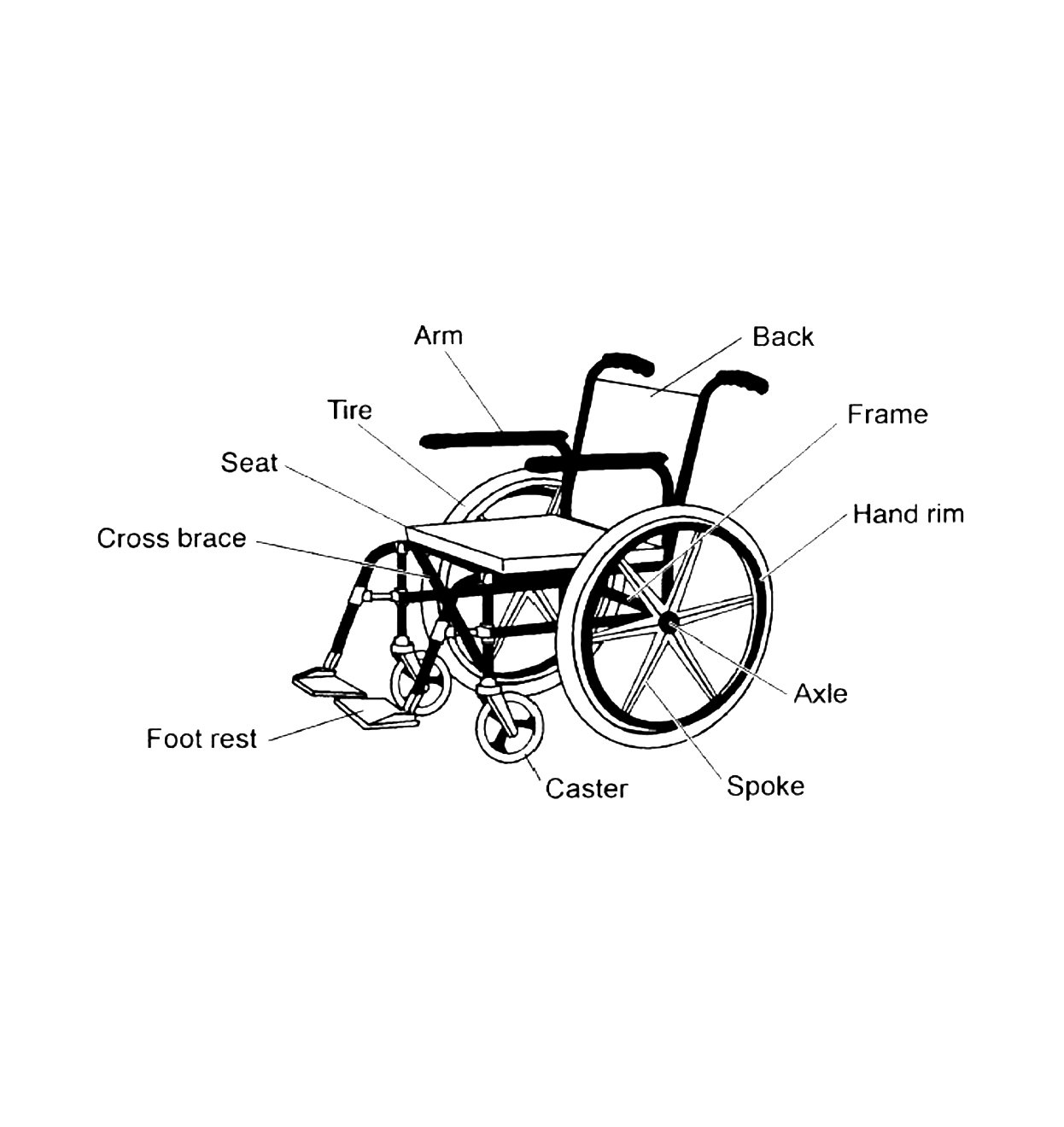
Wheelchair Maintenance Guide.
We at Access Medical appreciate being your wheelchair provider. Repair service from Access Medical includes the following:
Over the phone diagnosis and trouble-shooting at 760-929-2828
Hours of Operation 9:00 AM - 5:00 PM Monday – Friday
Our Manufacturer Certified Technicians are the highest trained in the industry
We provide an annual 20 point Safety Inspection and battery replacement
Coverage and insurance verification for all repairs
Rental equipment available during major services
Take charge of the care of your own wheelchair.
Maintenance of your new equipment is important to preserving your mobility and independence. If your equipment breaks down, it can be an inconvenience, a hardship, and may even put you in danger. You can help keep your chair operating and maintained by being knowledgeable about your wheelchair,
taking care of problems before they put you out of commission, and having our phone number (760-929-2828) always available. As the owner and operator of your wheelchair, you will usually be the first person to notice when your chair is not functioning properly. You may not be able to perform the basic daily and
weekly cleaning and upkeep yourself, but you can set up a routine that can be followed by your caregivers, family members or others to monitor your chair for problems. To keep your equipment running smoothly you will need to take care of minor problems, as well as having your service dealer take care of major repairs.
Know your equipment and be organized.
The process of maintaining your wheelchair begins on the day that your new chair is delivered. Read your warranty. You will be better able to handle problems as they arise if you have the following information and tools available and close at hand:
Owner’s manual – Your owner’s manual contains valuable information about your wheelchair. It describes how to care for your equipment, items that are covered under warranty and the tools that you will need for simple maintenance. Keep your owner’s manual in a safe place and refer to it often for guidance.
Set of Tools - Assemble and store a set of tools that you will need to have on hand for maintenance and emergencies. The following items can be with you in a pouch or box:
Phillips and flat head screw drivers
Allen wrench set
Crescent wrench
Spoke wrench
Tire repair kit
Information & Phone Numbers - Prepare a card or notepad that lists important information and phone numbers for emergencies. This card can be laminated and concealed in the chair (to provide security for children or other vulnerable individuals). The information should contain the following at a minimum:
Your name (and spouse, relative, other contact person) address, phone number
Your doctor’s name and phone number
Wheelchair make, model and manufacturer’s toll free number
Our phone number (which is on a sticker attached to the frame of your wheelchair)
Phone number of the public para-transit service or private transport service
Maintenance you can perform.
With innovative design and features, today’s wheelchairs present fewer potential problems. However, you still need to be aware of and monitor for common equipment failures. Regular maintenance can help extend the life of your chair and reduce the number and cost of repairs.
Regular service includes keeping the chair clean, checking tires for wear and air pressure, tightening screws, and monitoring for worn out cushions, pads, positioning equipment, and other parts. If you are unsure of performing a procedure or you encounter a problem, contact us at 760-929-2828.
Maintenance For All Wheelchairs.
Keeping your wheelchair clean will not only help keep you healthy and free of infections, but it will make it easier to identify equipment problems as they arise. To keep your wheelchair clean, you can wipe down the surfaces with a damp cloth. Use a mild detergent or a stronger cleaner for stains and sticky spots. Manufacturers often recommend using a car wax on the frame to make regular cleaning easier. Use a sharp tool or pick and carefully clean the wheel axle or caster bearing of any accumulation of hair, string, or other items that can interfere with the rotation of the wheels.
Check the frame for any cracks or breaks in the metal. Any potential problems need to be reported. The upholstery also should be monitored for cracks or tears where the fabric folds or where there are screws through the
fabric. Any problems related to fabric wear will need to be taken care of by our repair department. If you rely on a seat cushion, check whether it is still providing the padding and support you need. Call us for a seat adjustment.
Another regular activity is to check all nuts and bolts on the chair to verify that they are tightened (except for the cross brace pin). If you need to replace any parts, be sure that you are using parts that match those that were supplied by the manufacturer and Access Medical. Check that all parts that fold, swivel, pivot, and are removable do so easily. For example, be sure that removable arm rests, foot rests, and braces, etc. are working properly. The cross brace should fold easily without sticking. The center pin should move freely (this bolt is never tightened).
Wheelchairs with reclining backs or tilt mechanisms should recline and return to upright without difficulty. Instead of using petroleum oil on your wheelchair, use an all-purpose silicone lube spray to lubricate the flex points on your chair.
Your regular monitoring and maintenance can ensure that your wheelchair is operating safely. Your wheel lock needs to be checked to be sure that it engages and releases properly and does not rub against the tire. The lock needs to operate in such a way that it can be engaged and released without having to use excessive force. Also, the casters (front wheels) can present a safety hazard when they are worn out. Check your casters for cracks in the spokes that may eventually cause the caster to collapse.
Maintenance For Power Wheelchairs.
Power wheelchair users can monitor their equipment by ensuring that moving parts are free of entanglements from wires and cords. You can also check that all electrical connections are firmly in place and free of dirt and corrosion. If you loosen or remove any wires, be sure that you reconnect it in the right place. Most power chairs will have color-coded wiring to help prevent errors. An incorrect wiring connection can damage
your chair and result in personal injury due to a serious burn. Your batteries will last longer and perform better if you are careful to keep them charged. Keep track of your battery charge indicator and plug in your charger when the gauge shows less than half a charge. Check with the battery manufacturer for specific charging information.
Practical Advice.
Do
Check your tire pressure; inflation guidelines are on the outside of the tire.
Inflate your tires with a hand pump or bicycle pump.
Check to be sure that your wheel brake does not rub against the tire.
Wash the upholstery lightly with soapy water at least monthly.
Check nuts, bolts, and screws weekly and tighten as needed.
Check the front casters to see that they turn and pivot properly. If caster nut is too tight it will “flutter”(move quickly from side to side); if it is too loose, it will make the chair difficult to steer.
Check your wheel alignment. Glide the rider-less chair on a smooth surface – if the chair veers to either side, report it to us at 760-929-2828.
Inspect your chair for cracks in the frame – these should be reported immediately.
Wrap a clear plastic bag over your power controls if you must travel in the rain. (Power Wheelchair)
Keep your battery charged: If the battery (Power Wheelchair)
charge indicator is less than ½, plug it in for a recharge. (Power Wheelchair)
Listen to your motor and become familiar with the sounds that it makes. You will then notice changes in sound indicating that a belt, bearing or other moving part is malfunctioning. (Power Wheelchair)
Don’t
Do not inflate tires at a gas station –the high pressure can damage your tires.
Do not wash your chair in the shower or at a car wash – excess moisture can rust parts.
Do not attempt to oil the bearings on your chair – this requires a technician.
Never use petroleum based oil to lubricate your chair.
Don’t allow moisture or liquids to come into contact with electronic parts; avoid operating in the rain. (Power Wheelchair)
Don’t allow your chair to get out of control; turn off the power when transferring or when using a wheelchair lift. (Power Wheelchair)
Never allow your battery to discharge (run down) entirely; this may require replacement of the battery. (Power Wheelchair)
Do not leave your power chair or scooteroutside in the sun, rain, or heat for an extended amount of time. This can cause rust, moisture buildup, and wear, which can permanently damage your chair. (Power Wheelchair)
Do not drive your power chair or scooter over gravel, rough terrain, uneven pavement, water, grass, or mud. Doing so can cause damage to the electrical system. (Power Wheelchair)
Understand the cost of repairs and what is covered by your health plan.
Your wheelchair will operate more safely and efficiently if you work with your service dealer to get essential maintenance performed on your chair regularly. To avoid unexpected expenses and misunderstandings, it is best if you understand the services that are paid for by your health plan and the services that you will be expected to pay for yourself.
How repairs are authorized and paid for: As a general rule, Medicare and/or Medi-Cal will not pay for routine cleaning, testing, or regular check-ups of your equipment. The following general coverage restrictions apply:
Medicare -
Rental Wheelchairs: The Medicare rental includes service and maintenance charges. After 15 months of rental, Medicare will pay a fee every 6 months for service or maintenance. (Recipient or their secondary will pay 20% copay)
Purchased wheelchairs: Medicare pays for reasonable repairs. (Recipient or their secondary will pay 20% copay)
Replacement equipment: Medicare pays for replacement equipment if there has been permanent damage, wear and tear, or if your condition changes, resulting in a need for new equipment (A new prescription and evaluation is required.)
Medi-Cal -
Replacement parts and labor charges are generally covered, however most parts require a TAR (Treatment Authorization Request) TAR is required for any replacement part that is being supplied prior to the expiration of its life expectancy and the entire repair is greater than $250. A physician’s order is required for all Medi-Cal services of equipment.
Access Medical Services.
In Shop Service
We are delighted to provide excellent “In Shop” customer service. Our certified repair facility is staffed with quality trained technicians and customer greeting/waiting areas. If equipment is dropped off we can diagnosis and order parts right away. If you cannot bring your chair in to our service facility, we can help arrange for pick-up and delivery.
In Home Service
We can bring our mobile shop and technician to you. Customers needing “In Home” services can expect a service technician to be available within 7 to 10 business days. Customers residing outside our immediate service area will be scheduled for the first available route. These routes vary by location, please call for details at 760-929-2828.
Warranty / Returns
Access Medical honors all Manufacturers’ warranties on parts for the products we sell. Warranty claims are processed according to manufacturers’ guidelines and in accordance with the law. Labor charges may apply to replace specific warrantied parts. Returns are accepted on equipment determined to be unsuitable at the time it is fitted, rented or sold.
Common Questions
-
Some power wheelchairs are easily dissembled and can be placed in the trunk of a vehicle. These pieces tend to be heavy and difficult to lift. It is suggested that you purchase a wheelchair lift or wheelchair ramp for access to your vehicle.
-
In order to provide you with fast superior service, we recommend that you call us at 760-929-2828 or complete the online appointment form to schedule an appointment with our trained technicians.
-
The older the batteries get, the quicker they will die and need charging. Batteries tend to last 12 to 24 months before needing to be replaced.
-
The batteries should be charged for at least 8 hours at a time. If you use an electric wheelchair every day, you should charge the batteries every day.
-
Your electric wheelchair should have a manual that will outline the basic maintenance. Generally, an electric wheelchair should be serviced every year to ensure that it is functioning properly.
-
Yes. Please refer to the manufacturer's instruction manual to determine the details of warranty.
-
Yes. Medicare and most private insurances require wheelchair and scooter repair to have documented proof of medical necessity. We will work with your doctor to receive a written Rx.
-
Yes. We are happy to provide a rental wheelchair while we repair yours. Availability varies. Please check with us to determine if a suitable rental wheelchair is available.
-
Yes. It will, however, depend on the availability of parts to return your equipment to safe and original manufacturer specifications as well as insurance coverage and verification.
-
We always strive to process your repair as soon as possible. Repair times vary and depend on many factors, such as your insurance coverage, parts availability, and your doctor's prescription if needed.
-
1) Charge the batteries in accordance with your user's manual.
2) The chair's power cord (or off-board charger) must be plugged directly into the wall. (Do not plug the cord into an extension cord or surge protector, this will reduce the batteries' charge ability).
3) The power cord must be completely removed from the wall before use. If using an off-board charger, make sure the power cord is also disconnected from the power chair or scooter.
4) Batteries must be consistently used and charged. Batteries that sit for an extended period of time without being used will lose their charge.
5) Do not keep the power chair or off-board charger plugged into the wall for more than 24 hours. Doing so will reduce the batteries' ability to retain the charge.
6) If you are planning on using your power chair or scooter throughout the day, it is recommended the batteries be charged for at least 8 hours the day before.

Preserving your mobility and independence.
Get your repair started.
Complete this form to provide us with some basic information and we will contact you to schedule a repair. Click here to download the prescription form and contact your Doctor to get a repair prescription.
Schedule a Free Cleaning or Seat Adjustment.
Schedule an appointment at one of our convenient locations to get a free wheelchair cleaning or seat adjustment.
Schedule an appointment at one of our convenient locations to get a free wheelchair cleaning or seat adjustment.



